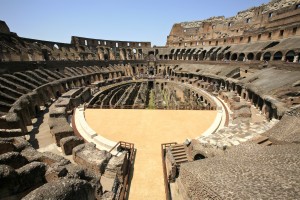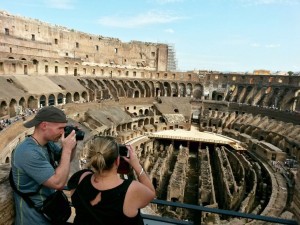 The Colosseum Underground lies beneath the massive stone amphitheater called the Colosseum commissioned around 70-72 A.D by the then Emperor Vespasian of the Flavian dynasty. Opened in 80 A.D. by Titus, the son of Emperor Vespasian. The Colosseum was officially named the Flavian Amphitheater. It was used for four centuries and then was neglected until the 18th century and used as a source of building materials. Though a large part of the originally built amphitheater has been destroyed, it remains a popular tourist attraction and an iconic symbol of Rome. Before Emperor Vespasian took the throne, there was an emperor named Nero who ruled in 68 A.D. His weak rule caused numerous civil wars and came to an end when he committed suicide. When Vespasian took over, he tried to restore the Senate’s authority and promote public welfare. In 70 A.D. Vespasian gave back the green space near the center of the city to the people. That is where Nero had built a baroque palace for himself after a great fire had burned much of Rome in 64 A.D. On the site that the palace stood, Vespasian decreed to build a new amphitheater where the general public could enjoy games like gladiator battles and other spectacles. After more than a decade of construction, Titus dedicated the Colosseum in 80 A.D. with a festival of 100 days of games. Its final stages of construction were completed under the reign of Titus’ brother, Domitian.
The Colosseum Underground lies beneath the massive stone amphitheater called the Colosseum commissioned around 70-72 A.D by the then Emperor Vespasian of the Flavian dynasty. Opened in 80 A.D. by Titus, the son of Emperor Vespasian. The Colosseum was officially named the Flavian Amphitheater. It was used for four centuries and then was neglected until the 18th century and used as a source of building materials. Though a large part of the originally built amphitheater has been destroyed, it remains a popular tourist attraction and an iconic symbol of Rome. Before Emperor Vespasian took the throne, there was an emperor named Nero who ruled in 68 A.D. His weak rule caused numerous civil wars and came to an end when he committed suicide. When Vespasian took over, he tried to restore the Senate’s authority and promote public welfare. In 70 A.D. Vespasian gave back the green space near the center of the city to the people. That is where Nero had built a baroque palace for himself after a great fire had burned much of Rome in 64 A.D. On the site that the palace stood, Vespasian decreed to build a new amphitheater where the general public could enjoy games like gladiator battles and other spectacles. After more than a decade of construction, Titus dedicated the Colosseum in 80 A.D. with a festival of 100 days of games. Its final stages of construction were completed under the reign of Titus’ brother, Domitian.
The Colosseum Games
The most loved spectacle performed in the Colosseum was the gladiatorial combat. Men would fight as the excited crowd would watch and cheer. The gladiators would fight with the objective of harming the opponent rather than killing them quickly so that the fight could last longer enough to entertain the crowd. Some gladiators, called bestiarii, fought animals such as tigers, bears, and rhinos. Another game played there was chariot racing held on the first racetracks called circuses. Two or four horse chariots would run seven laps which ranged from three to five miles. Other games included the equestrian events. In other horse races, riders would begin the race on horseback but later dismount and run on foot to finish. The Colosseum had box seats for wealthy and powerful people just like modern day stadiums. The upper level was reserved for the commoners. Those who attended included slaves, senators, Vestal Virgins, and the general public.
 The Colosseum Underground
The Colosseum Underground
The Colosseum underground tunnels were built to connect different parts of the arena. One led to Magnus, the gladiator school. These were used as the gladiators’ entrance to the arena. Another tunnel led to the Bestiaries’ school where animals stayed. A tunnel named spoliarium connected to the “Gate of Death” where dead bodies were dragged and stripped of their armor and weapons before being cleaned, given new armor, and paraded around the arena for the public to pay their respects. Another tunnel lead to the Imperial Palace, a special entrance for the Emperor.
The Colosseum Underground, the backstage of one of the most exciting public events in ancient Roman society, is a perfect place to tour to visualize the behind the scenes actions that made such spectacles possible.
If you’re in Rome and want to explore the depths of the Colosseum even more, check out our Colosseum Underground Tour.

